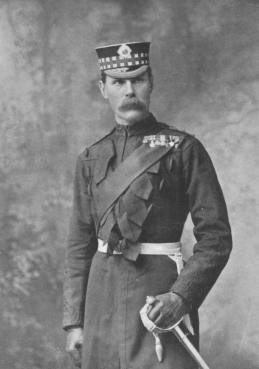
The 1st Division is an infantry division of the British Army that has been formed and disestablished numerous times since 1809 and is still currently active as the 1st Division. Lieutenant-General Arthur Wellesley raised the division for service in the Peninsular War, which was part of the Coalition Wars of the Napoleonic Wars. The division was disestablished in 1814 but reformed the following year for service in the War of the Seventh Coalition. It then fought at the Battle of Waterloo, where it repulsed numerous attacks, including the final attack of the day that was launched by the French Imperial Guard. Following the battle, the division marched into France and became part of the Army of Occupation before being disbanded a few years later.
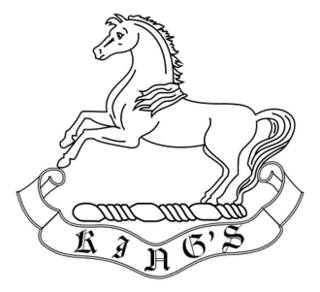
The King's Regiment (Liverpool) was one of the oldest line infantry regiments of the British Army, having been formed in 1685 and numbered as the 8th (The King's) Regiment of Foot in 1751. Unlike most British Army infantry regiments, which were associated with a county, the King's represented the city of Liverpool, one of only four regiments affiliated to a city in the British Army. After 273 years of continuous existence, the regiment was amalgamated with the Manchester Regiment in 1958 to form the King's Regiment (Liverpool and Manchester), which was later amalgamated with the King's Own Royal Border Regiment and the Queen's Lancashire Regiment to form the present Duke of Lancaster's Regiment (King's, Lancashire and Border).

The 2nd Infantry Division was an infantry division of the British Army that was formed and disestablished numerous times between 1809 and 2012. It was raised by Lieutenant-General Arthur Wellesley for service in the Peninsular War as the 2nd Division. It was disestablished in 1814, but re-formed the following year for service in the War of the Seventh Coalition. The formation fought at the Battle of Waterloo and played an important role in defeating the final French attack of the day. It then marched into France and became part of the Army of Occupation, and was the only British force allowed to march through Paris. In December 1818, the division was disbanded once again.

The Liverpool Scottish, known as "the Scottish", was a unit of the British Army, part of the Army Reserve, raised in 1900 as an infantry battalion of the King's. The Liverpool Scottish became affiliated to the Queen's Own Cameron Highlanders in the 1920s and formally transferred to the regiment in 1937 with its identity preserved. Reflecting the Territorial Army's decline in size since the late 1940s, the battalion was reduced to a company in 1967, then to a platoon of "A" (King's) Company, King's and Cheshire Regiment in 1999. In 2006, the company was incorporated into the 4th Battalion, Duke of Lancaster's Regiment.
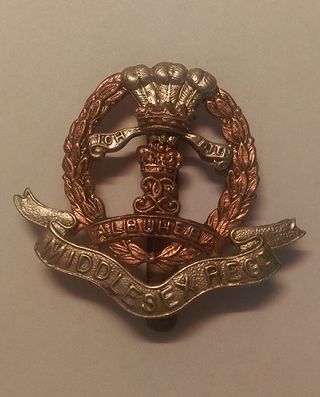
The Middlesex Regiment (Duke of Cambridge's Own) was a line infantry regiment of the British Army in existence from 1881 until 1966. The regiment was formed, as the Duke of Cambridge's Own (Middlesex Regiment), in 1881 as part of the Childers Reforms when the 57th (West Middlesex) and 77th (East Middlesex) Regiments of Foot were amalgamated with the county's militia and rifle volunteer units.
The Liverpool Irish is a unit of the British Army's Territorial Army, raised in 1860 as a volunteer corps of infantry. Conversion to an anti-aircraft regiment occurred in 1947, but the regimental status of the Liverpool Irish ceased in 1955 upon reduction to a battery. Since 1967, the lineage of the Liverpool Irish has been perpetuated by "A" Troop, in 208 Battery, 103rd Regiment. The 103rd has provided individual reinforcements to regular artillery regiments equipped with the AS-90 and L118.
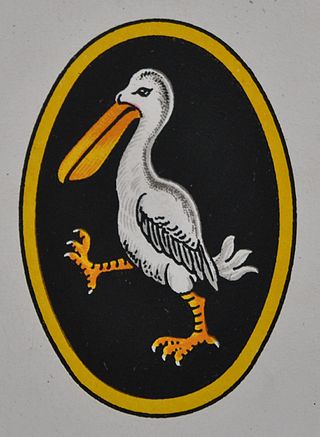
The 62nd Division was an infantry division of the British Army that saw active service on the Western Front during the First World War.

98th Brigade was an infantry formation of the British Army created to command 'Kitchener's Army' units during World War I. It served on the Western Front from 1916, seeing action on the Somme, at Arras and Ypres, during the German spring offensive and the final Allied Hundred Days Offensive.

The 2nd (Seaham) Durham Artillery Volunteer Corps was a part-time unit of Britain's Royal Artillery raised in County Durham by the Vane-Tempest family during an invasion crisis in 1860. It became a permanent part of the Volunteer Force and later the Territorial Force, and fought as field artillery on the Western Front in World War I. Before World War II it became an anti-aircraft unit that served in the Battle of Britain, the Blitz and in the Far East where it converted to medium artillery in the Burma Campaign. Postwar, it continued to serve in the air defence role in the Territorial Army until 1955.
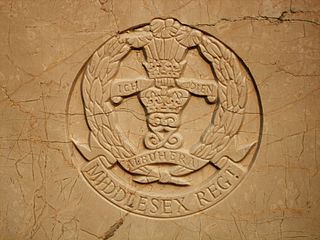
The 9th Battalion, Middlesex Regiment was an infantry battalion of the British Army. Part of the Volunteer Force, later the Territorial Force, the battalion was part of the Middlesex Regiment and recruited from the north-western suburbs of London. It served as infantry in the Mesopotamian campaign during World War I and as an air defence regiment during and after World War II.

The 10th Battalion, Middlesex Regiment, was an infantry unit of Britain's Territorial Force from 1908 to 1920. Based in Ravenscourt Park, West London, its part-time soldiers saw service at Gallipoli, in Palestine, and on the Western Front during the First World War. After the war the battalion was amalgamated into a unit of the new Royal Corps of Signals.

The 5th (Cyclist) Battalion, East Yorkshire Regiment was a mobile coast defence unit of Britain's Territorial Force. It was formed in 1908 from a nucleus provided by a Volunteer battalion first raised in 1859. It carried out its defence duties along the East Coast throughout World War I and after the war it was incorporated into a unit of the new Royal Corps of Signals.
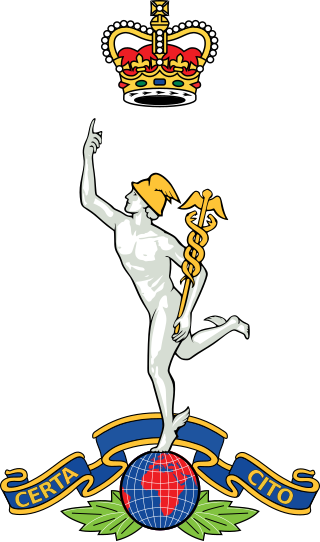
50 (Northumbrian) Signal Regiment was a Territorial Army (TA) unit of the British Army's Royal Corps of Signals. It had its origins in a signal company and a cyclist battalion formed in 1908 and it provided the divisional signals for the 50th (Northumbrian) Division and its duplicates during World War II. Its successors continued in the postwar TA until 2009.

The Hull Rifles, later the 4th Battalion, East Yorkshire Regiment, was a unit of Britain's Volunteer Force first raised in Kingston upon Hull in 1859. During the First World War it served on the Western front, seeing a great deal of action at Ypres, the Somme, Arras, and in the German spring offensive, when it was virtually destroyed. Its 2nd Line battalion garrisoned Bermuda for much of the war. During the Second World War the 4th Battalion was captured at the Battle of Gazala, but its wartime duplicate unit fought on through the Western Desert, Tunisia and Sicily, and then landed in Normandy on D Day. The battalion served in the postwar Territorial Army until 1960, and its successors in today's Army Reserve continue in Hull.
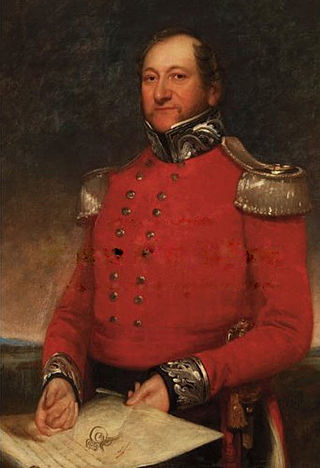
The Surrey Militia was an auxiliary military force in Surrey, England. From their formal organisation as trained bands in 1558 until their final service as the Special Reserve, the Militia regiments of the county served in home defence in all of Britain's major wars. They also saw active service during the Second Boer War, and trained thousands of reinforcements during World War I. After a shadowy postwar existence they were formally disbanded in 1953.
The 5th Middlesex Militia or Royal Elthorne Light Infantry was an auxiliary regiment raised in Middlesex in the Home counties of England just before the Crimean War. It later became part of the Middlesex Regiment. Primarily intended for home defence, it served in England and Ireland during Britain's major wars, and saw active service during the Second Boer War. It was converted to the Special Reserve under the Haldane Reforms and supplied reinforcements to the Royal Fusiliers' fighting battalions during World War I. After a shadowy postwar existence the unit was finally disbanded in 1953.












